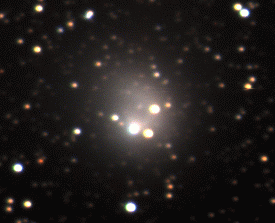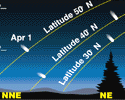

SPEEDING toward the inner solar system at nearly two million miles a day, Comet Hale-Bopp, C/1995 O1, is poised for a rendezvous with the Sun, and history, around the spring of 1997. Excitement is already building among professional and amateur astronomers about the new discovery, predicted to become the brightest comet in at least two decades. Fortunately it was spotted more than 1-1/2 years before perihelion while still 7 astronomical units (a.u.) from the Sun, giving observers plenty of time to get ready.
Observers recovered Hale-Bopp in the predawn sky in mid-February 1996. By June the comet will be much higher and easier, glowing at perhaps 7th or 8th magnitude between Sagittarius and Aquila in the south. By August it will be well placed in Serpens Cauda during the evening hours and may be as bright as 6th magnitude. September and October find the comet in Ophiuchus high in the southwest right after dark, still with a predicted magnitude of about 6. By early December Hale-Bopp will be getting very low in the west after dusk, but brightening to 5th magnitude. Toward year's end the comet is once again too close to the Sun for observation.
 Comet Hale-Bopp in 1996 (90K gif): Comet Hale-Bopp's path through the sky in 1996. By mid-year experienced viewers in dark locations might begin to glimpse the comet's faint glow with the naked eye as it climbs high in the sky. By then it should be fairly easy to spot in binoculars and small telescopes. Adapted from Sky & Telescope.
Comet Hale-Bopp in 1996 (90K gif): Comet Hale-Bopp's path through the sky in 1996. By mid-year experienced viewers in dark locations might begin to glimpse the comet's faint glow with the naked eye as it climbs high in the sky. By then it should be fairly easy to spot in binoculars and small telescopes. Adapted from Sky & Telescope.
Comet Hale-Bopp's Path
The following orbital elements (equinox 2000.0), calculated by
Brian Marsden, are adapted from Minor Planet Circular 25,623:
Perihelion date, T 1997 Mar. 31.96 UT
Perihelion distance, q 0.9143 a.u.
Eccentricity, e 0.9953
Argument of perihelion 130.57°
Longitude of ascending node 282.47°
Inclination, i 89.43°
Hale-Bopp should be at its best for midnorthern observers in April, especially from dark rural and mountain sites before new Moon on April 7th and after full Moon on the 22nd. For those in higher latitudes like Canada and northern Europe the comet will actually be circumpolar at the start of April, hence visible all night. Throughout May the object remains prominent in the northwestern sky after sunset as it moves through Perseus, Taurus, and Orion. By June 1997 the comet will probably fade rapidly as it recedes from both the Sun and Earth.
 Comet Hale-Bopp in 1997 (23K gif): Left: For observers throughout the Northern Hemisphere, Comet Hale-Bopp will be well placed in the predawn sky as it approaches perihelion in the spring of 1997. If a tail develops it will probably point away from the Sun, as suggested here. Right: The comet may not attain full splendor until it enters the evening sky. Even if Hale-Bopp's tail grows as long in space as that of the Great Comet of 1811 (1.2 astronomical units one month after perihelion), foreshortening will limit it to a fairly compact 10° or so in early May. These Sky & Telescope diagrams show the comet when it is highest in a dark sky on each date, with the Sun 18° below the horizon.
Comet Hale-Bopp in 1997 (23K gif): Left: For observers throughout the Northern Hemisphere, Comet Hale-Bopp will be well placed in the predawn sky as it approaches perihelion in the spring of 1997. If a tail develops it will probably point away from the Sun, as suggested here. Right: The comet may not attain full splendor until it enters the evening sky. Even if Hale-Bopp's tail grows as long in space as that of the Great Comet of 1811 (1.2 astronomical units one month after perihelion), foreshortening will limit it to a fairly compact 10° or so in early May. These Sky & Telescope diagrams show the comet when it is highest in a dark sky on each date, with the Sun 18° below the horizon.
Just how bright Hale-Bopp will be around perihelion is difficult to forecast. Current total magnitude estimates range from a spectacular -2 (brighter than Sirius) to a respectable 0 (as bright as Vega) or +1 (like Pollux). But comets are notorious for their unpredictability, and Hale-Bopp may not be an exception.
Zdenek Sekanina (Jet Propulsion Laboratory) suggests that C/1995 O1 underwent a major outburst at the time of its discovery in July -- a temporary brightening caused by the exposure of fresh material in the comet's nucleus to solar heat and radiation. The exposed surface vigorously ejected vast quantities of silicate dust and volatile gases, which in turn reflected more sunlight and made the nucleus appear bright despite its great distance. Such nuclear outbursts were observed in Periodic Comet Schwassmann-Wachmann 1. According to Sekanina, Hale-Bopp may grow fainter in the coming months as its dust and gases slowly disperse in space.
Others cite the erratic behavior of Comet Austin in 1989. Austin appeared very bright initially and then suddenly "fizzled" as it neared the Sun and Earth. If the same thing happens to Hale-Bopp, it could appear much dimmer and less impressive than predicted -- perhaps barely visible to the naked eye -- when it arrives in early 1997.
On the other hand, Brian G. Marsden (Central Bureau for Astronomical Telegrams) remains optimistic. He believes that Hale-Bopp is intrinsically bright. In fact, he compares it to the Great Comet of 1811, which exhibited a magnificent tail that stretched more than 1 a.u. across space.
Throughout August Hale-Bopp's overall brightness deviated little from the previous month's estimates -- magnitude 10 or 11. However, its nuclear region underwent fluctuations almost every night. Sky & Telescope's Stephen James O'Meara, observing on August 11th with Lick Observatory's 36-inch refractor at 588x and 1,176x, noted that the comet displayed a "very sharp pseudonucleus (approximately magnitude 15) surrounded by a 40-arcsecond inner coma." The following night he reported the pseudonucleus was much fainter, barely visible.
On August 13th O'Meara saw the starlike core appear bright again, with the inner coma swollen to 60 arcseconds. The latter even had "hints of counterclockwise spiral structure. Equally surprising was a 30-arcsecond-long jetlike feature flowing due north of the pseudonucleus."
Veteran comet watchers Charles Morris and John Bortle, observing at about 70x with a 10-inch reflector from Lockwood Valley, California, and with a 16-inch reflector from Stormville, New York, respectively, also witnessed bewitching nuclear changes. They saw the comet's pseudonucleus evolve from a small, weak condensation within the coma on August 19th to a perfectly stellar, 12th-magnitude point the following night. "The comet seems to be undergoing continuous outbursts one after another, and there is no sign that this activity is letting up," according to Morris.
Normally, carbon monoxide (CO) and cyanogen (CN) emissions are detected in comets beginning to "turn on" as they approach the Sun. But astronomers Albert Nummelin, Anne-Marie Lagrange, and their colleagues at the European Southern Observatory in La Silla, Chile, using the 15-meter Submillimeter Telescope and the ESO 1.5-meter reflector, failed to detect the spectral signatures of these gases in Hale-Bopp in early August. They note that the object is still too far from the Sun for water ice, the main component of cometary nuclei, to sublimate efficiently. Thus, the "driving gas" responsible for Hale-Bopp's visible dust coma remains unknown. In a similar observation, Bortle noted that the comet's light is strongly suppressed by a Lumicon Swan-band filter, suggesting that the nucleus is producing predominantly dust with very little molecular carbon gas.
If the comet does brighten significantly, eclipse chasers in Mongolia and eastern Siberia may see Hale-Bopp with the naked eye 46° from the Sun during the total eclipse on March 9, 1997, along with Mercury, Venus, Jupiter, and Saturn. Fred Espenak (NASA-Goddard Space Flight Center) notes that only twice before have comets been seen during totality -- on May 17, 1882, from Egypt and on May 20, 1947, from Brazil.
Unlike Comet Shoemaker-Levy 9, which crashed into Jupiter in July 1994, Hale-Bopp will not collide with any planets, including the Earth (despite what some tabloids have already augured). On March 23, 1997, the comet makes its closest pass to our home planet at a safe distance of 123 million miles.
Clearly, C/1995 O1 is an important comet for astronomers and the general public. Sky & Telescope and SKY Online will carry detailed observing information as the spectacle unfolds.
Edwin Aguirre is an Associate Editor of Sky & Telescope magazine. He and his wife, Imelda Joson, coauthored a book on Halley's Comet in 1986.


Copyright © 1995 Sky Publishing Corporation, All Rights Reserved.